By Neil Arora
The recipe I recreated was from a recipe book by Catherine Cotton that contains both culinary and medical recipes. The book has its origins from 1698 England.
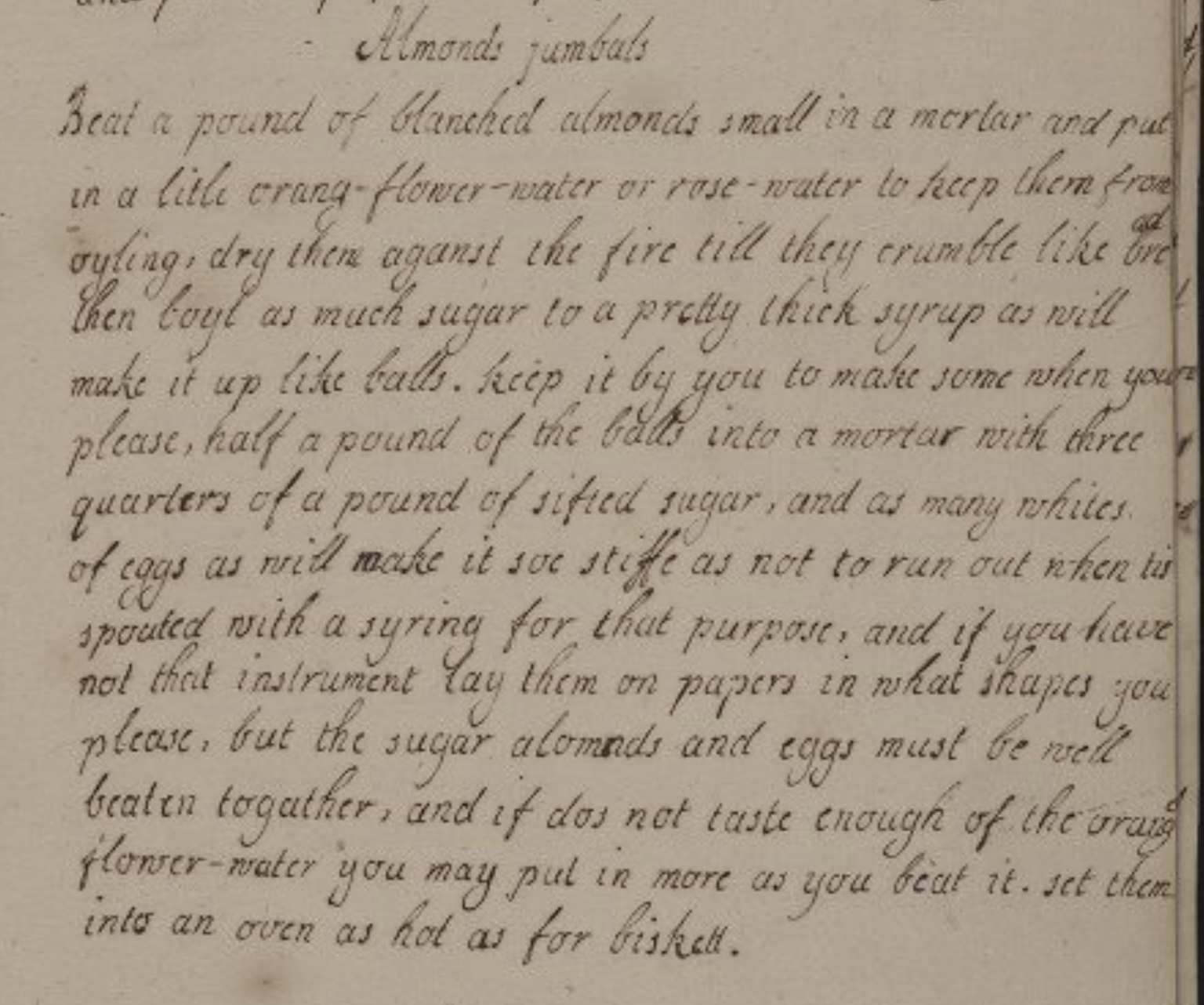
Almonds jumbals
Beat a pound of blanched almonds small in a mortar and put
in a litle orang-flower-water or rose-water to keep them from
oyling, dry them aganst the fire till they crumble like bread
then boyl as much sugar to a pretty thick syrup as will
make it up like balls. keep it by you to make some when you
please, half a pound of the balls into a mortar with three
quarters of a pound of sifted sugar, and as many whites
of eggs as will make it soe stiffe as not to run out when tis
spouted with a syring for that purpose, and if you have
not that instrument lay them on papers in what shapes you
please, but the sugar alomnds and eggs must be well
beaten togather, and if dos not taste enough of the orang
flower-water you may put in more as you beat it. set them
into an oven as hot as for biskett.
Beat a pound of blanched almonds small in a mortar and put in a little orange-flower-water or rose-water to keep them from oiling. Dry them against the fire until they crumble like bread. Then, boil as much sugar needed to make a pretty thick syrup as will make it up like balls. Keep it by you to make some when you please. Then, place half a pound of the balls into a mortar with three-quarters of a pound of sifted sugar, and as many whites of eggs as will make it so stiff as to not run out when it is spouted with a syringe for that purpose. If you have not that instrument, lay them on papers in whatever shapes you want to, but the sugar almonds and eggs must be well beaten together. If the mix does not taste like it has enough orange-flower-water, you may put in more as you beat it. Afterwards, set them into an oven as hot as for making biscuits to bake them.
I found this recipe interesting and wanted to recreate it for multiple reasons. One reason was that I clearly understood the recipe when I read it, and that the ingredients were simple. I would only need almonds, sugar, eggs, orange-flower-water, and rose-water to make it. The steps of the recipe are also straightforward for the most part, as you simply have to first toast a mixture of ground almonds and orange-flower-water/rose-water, add sugar and egg whites to it, and make them into balls/interesting shapes before baking them.
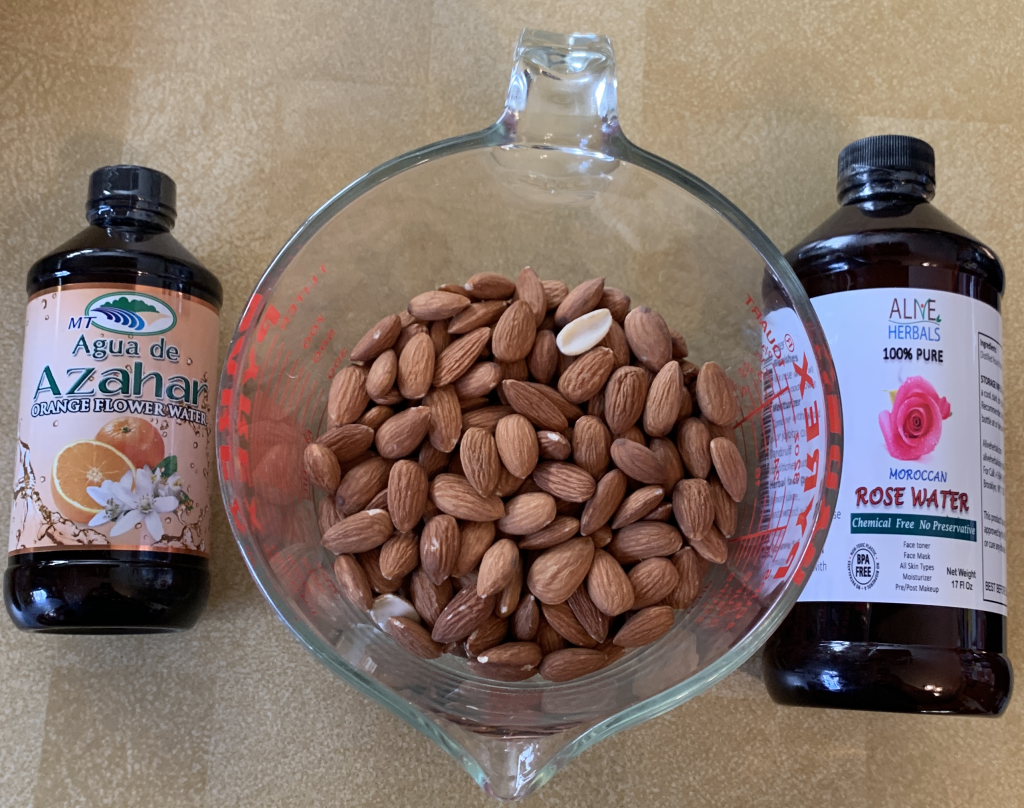
However, one thing that I did not fully understand when I was looking at the recipe was what exactly I was going to be making. Precisely, I did not know exactly what a “jumbal” is. From what I could gather, it was some sort of a baked good, like a cookie or pastry. I did some research, and found a definition for it in the Oxford English Dictionary which helped me understand exactly what a jumbal is.
It states that a jumbal is a “kind of fine sweet cake or biscuit, formerly often made up in the form of rings or rolls; now in U.S. ‘a thin crisp cake, composed of flour, sugar, butter, and eggs, flavored with lemon-peel or sweet almonds.’”
Another interesting thing I found in the Oxford English Dictionary page for “jumbal” was that it cites the word as being first used in the year 1615, in a recipe for “jumbles” in The English Housewife by Gervase Markham. One indication that can be drawn from this is that the word “jumbal” was a concept or word that was relatively new compared to others used in recipes during this time period, especially compared to other terms used in recipes in this time period. These include words such as “biscuit” or “cake”, which the dictionary cite as being used for the first time in 1330 and around 1230, respectively.

Recipe for “jumbles” from The English Housewife by Gervase Markham
After researching about “jumbals” in general, I went on to try and find other recipes for almond jumbals created during the early modern period. I was able to find a recipe for them from the Folger Manuscript V.a.429, fol. 52v, created around 1675-1750.

Recipe for “Almond Jumballs” from the Folger Manuscript
After reading this recipe from the manuscript, I realized how similar it is to that of Catherine Cotton’s, not only in the wording, but also in the ingredients and techniques used. The manuscript has multiple handwritings, as well as ownership inscriptions on the front, including those of Rose Kendall, Ann Cater, and Anna Maria Wentworth. This suggests that both the author of the “Almond Jumballs” recipe from the manuscript and Catherine Cotton may have based their own recipes on the same source recipe because of how similar they are to each other. Afterward, they likely just made their own, individual adjustments to their recipes.
I then compared the different jumble recipes from Gervase Markham’s book, the folger manuscript, and Catherine Cotton’s book. It was interesting to note the similarities between all of the recipes, as they all use egg whites and sugar as ingredients. They also use similar techniques, like beating the egg whites, shaping the jumbles in whatever shape one wants to, and then baking them on paper in an oven. Keeping in mind these similarities, it is reasonable to speculate that Catherine Cotton, and the writer of the “Almond Jumballs” recipe from the Folger manuscript could have both gotten ideas for how to make their recipes from Markham’s recipe for “jumbles”. It is also possible that Cotton or the manuscript author got their ideas from a newer source who pulled ideas for their own “jumbal” recipe from Markham’s book.
After researching the different recipes for jumbals, I prepped to recreate Catherine Cotton’s recipe. While doing so, another recreation for “Almond Jumbals”, done on the “Cooking on the Archives” blog was helpful when deciding on things like ingredient measurements and cooking times.
After doing so, I came up with the following recreation recipe for “Almond Jumbals”
Almond Jumbals
Ingredients
- 1/2 lb of almonds
- 1 Tablespoon of orange flower water
- 1 Tablespoon of rose Water
- 1 and 1/2 Cups of sugar
- 1/2 Cup of Water
- 2-3 egg whites
- 1 Cup Flour
Makes close to one dozen jumbals, more or less depending on the shape of jumbals made.
Steps
1. Begin by blanching your almonds. Do this by bringing a pot of water to a boil, and then adding your almonds in (no longer than 60 seconds, otherwise they will start to soften). Afterwards, strain the almonds and rinse them under cold water. Dry them, and then remove the skins.
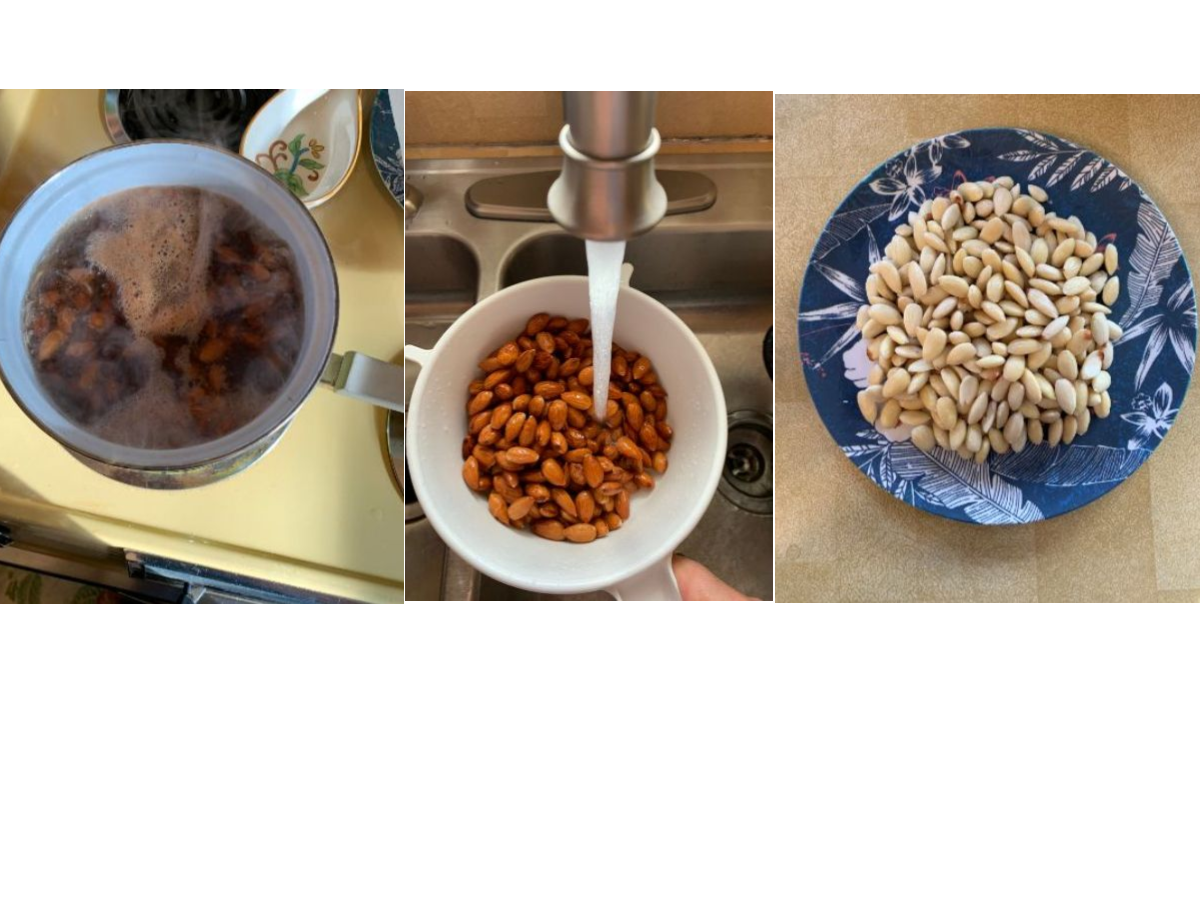
2. Next, grind the blanched almonds. Catherine Cotton’s recipe says to do so with a mortar, but for time purposes, I used a blender.

3. Mix the ground almonds with 1 tablespoon of Rose Water. Orange-flower-Water, however, may be used instead. Afterwards, toast the mixture until it is brown. I did so for 5 minutes at 450°F using a toaster oven, but if using a large oven, make sure to keep in mind the longer preheating time.

4. The next step is to make a “thick” syrup using sugar and water. This can be done by boiling a mixture of half a cup of sugar combined with half a cup of water. This is done until the sugar dissolves, which took around 3 minutes at high heat.
5. Afterwards, I added the sugar syrup to the toasted almond mix in a large bowl. Cotton’s recipe says that you can make balls out of the mix after adding the syrup, but I found it easier to do so after adding more sugar and the egg whites.
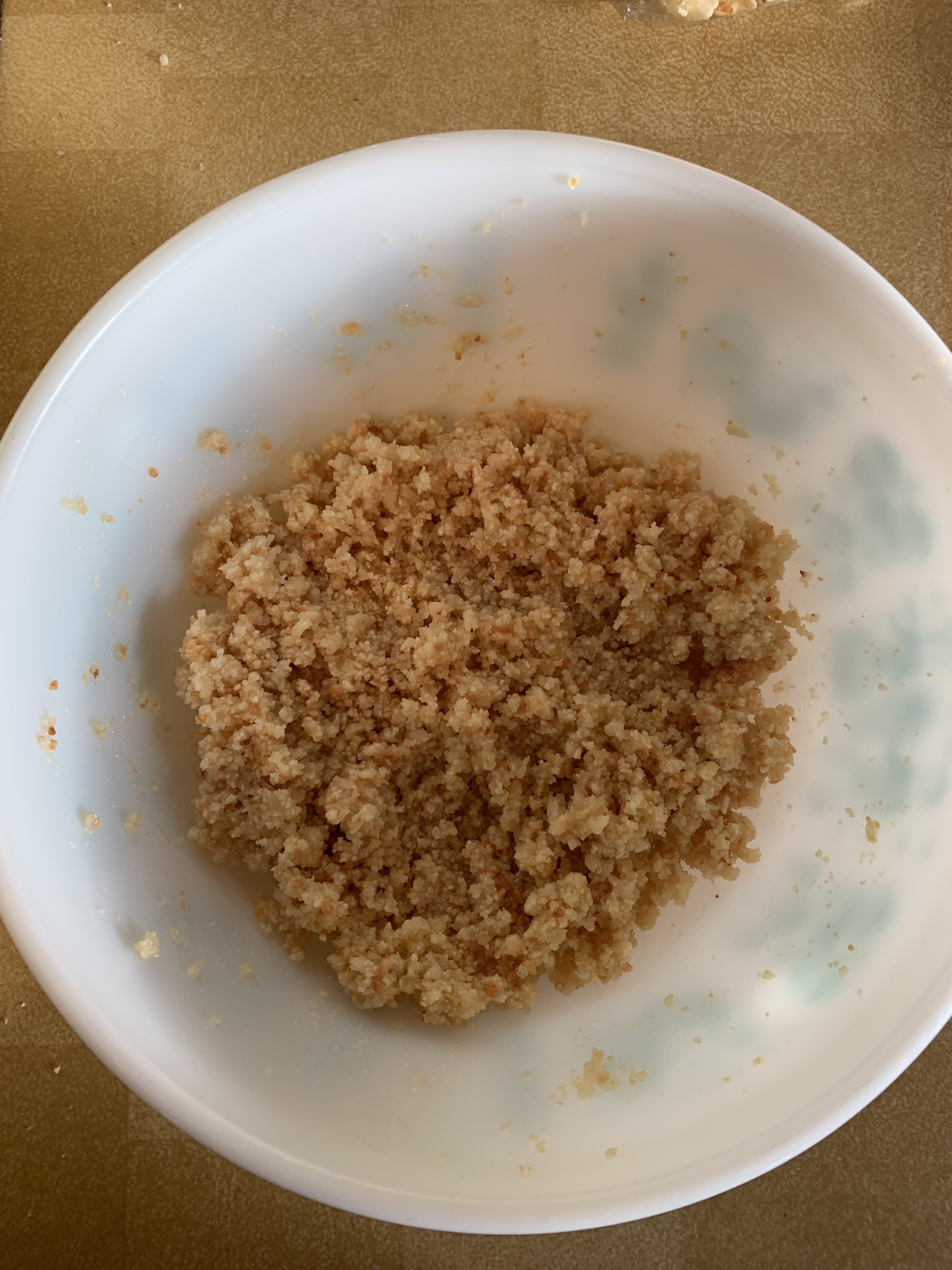
6. Afterwards, stir in 1 cup of sugar.
7. Next, obtain your egg whites, and mix them together well with the almond mixture. I added enough egg whites (around 2) until I felt the dough was moist. I also added 1 tablespoon of orange-flower-water at this step.
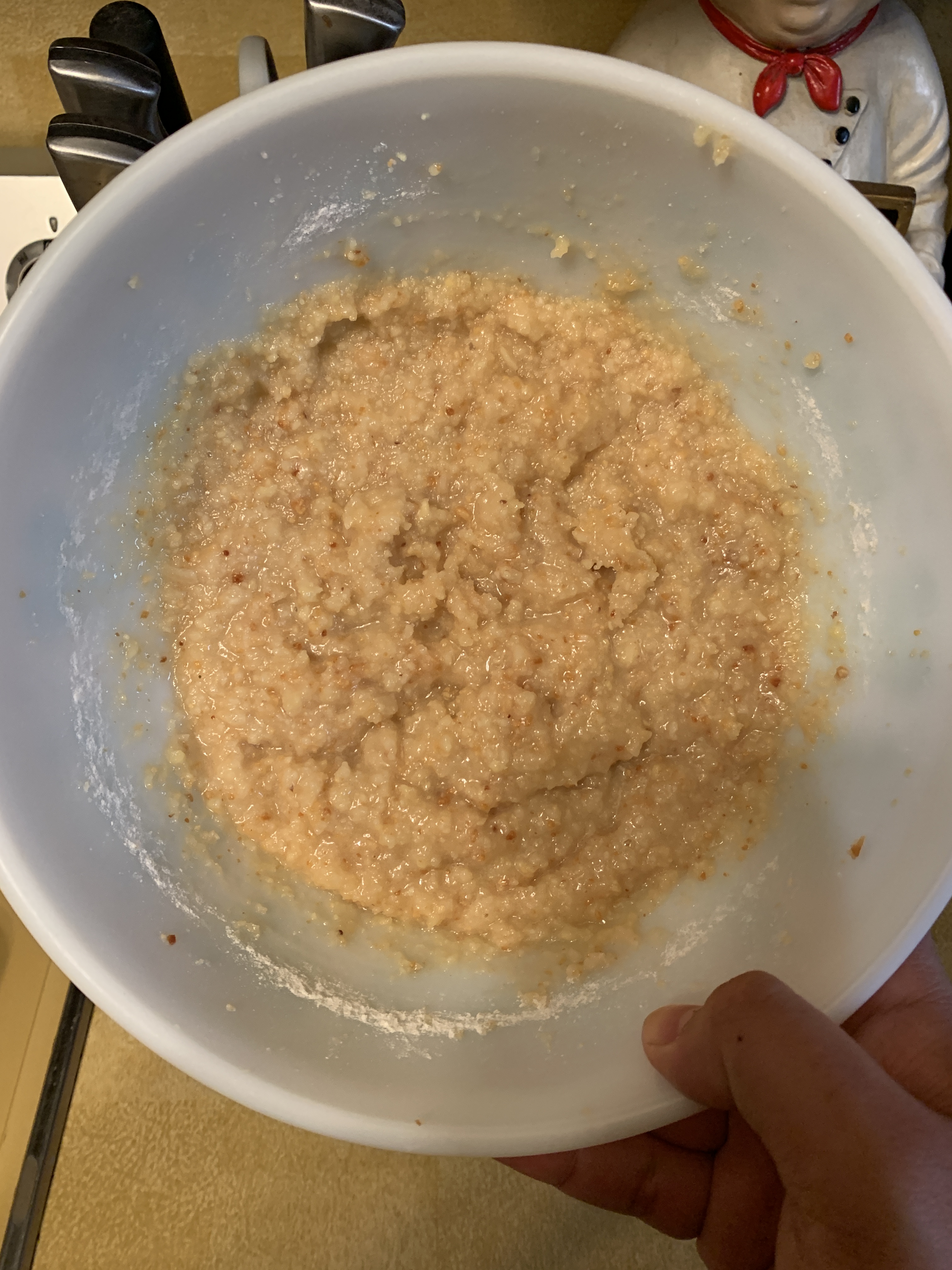
8. It was at this point where I realized that the dough was too runny and I knew, would not stay together enough to bake into jumbals. As a result, I had to deviate from Cotton’s recipe and add around 1 cup of flour to the mixture, which made it less runny and much thicker, more like traditional dough used for other baked goods.
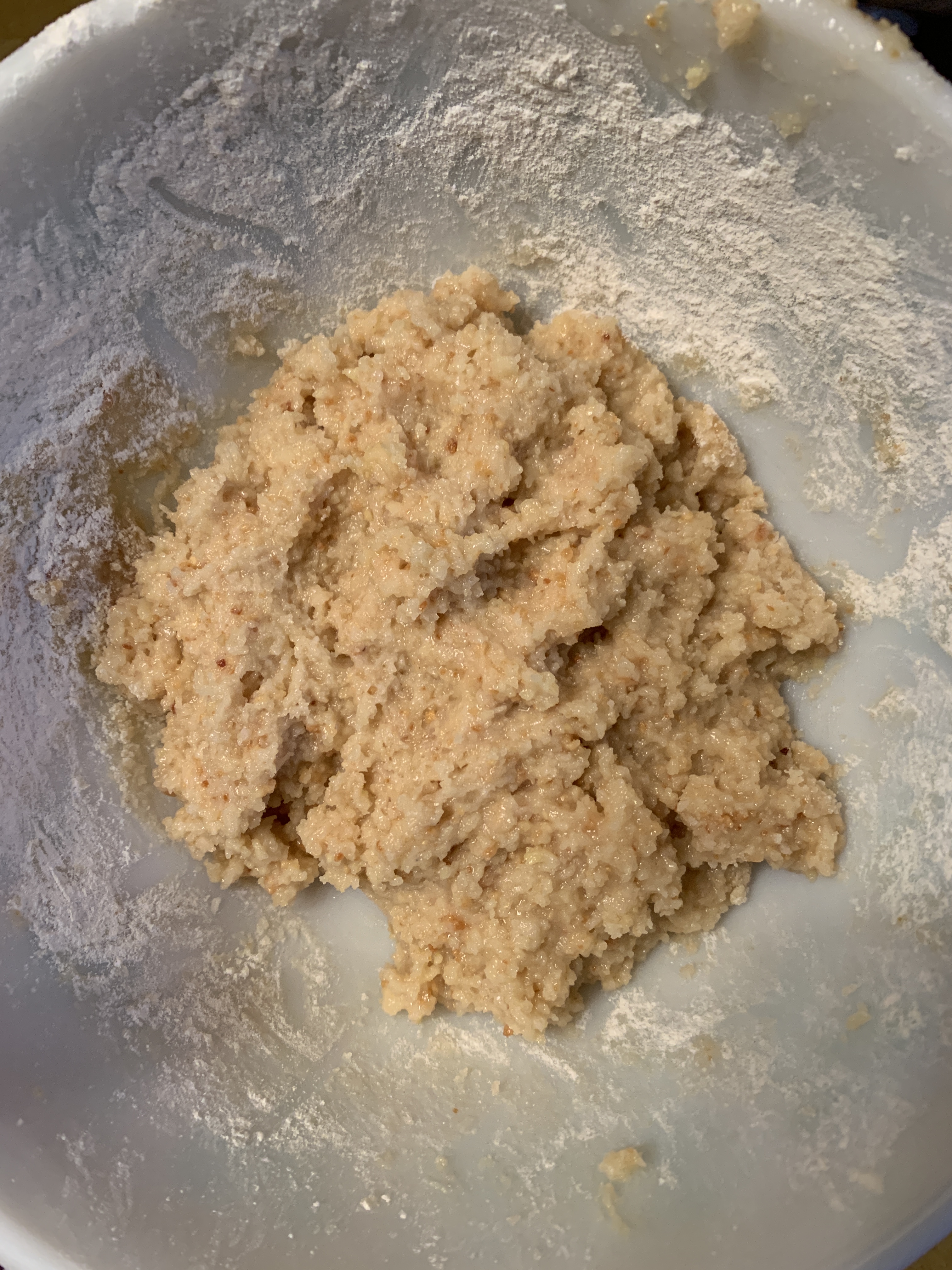
9. I did not have a syringe I could use, like in Cotton’s recipe, to pipe the final almond mixture through to make the shapes of the jumbals. Instead, I shaped the dough into different shapes like letters, as Cotton’s recipe says.
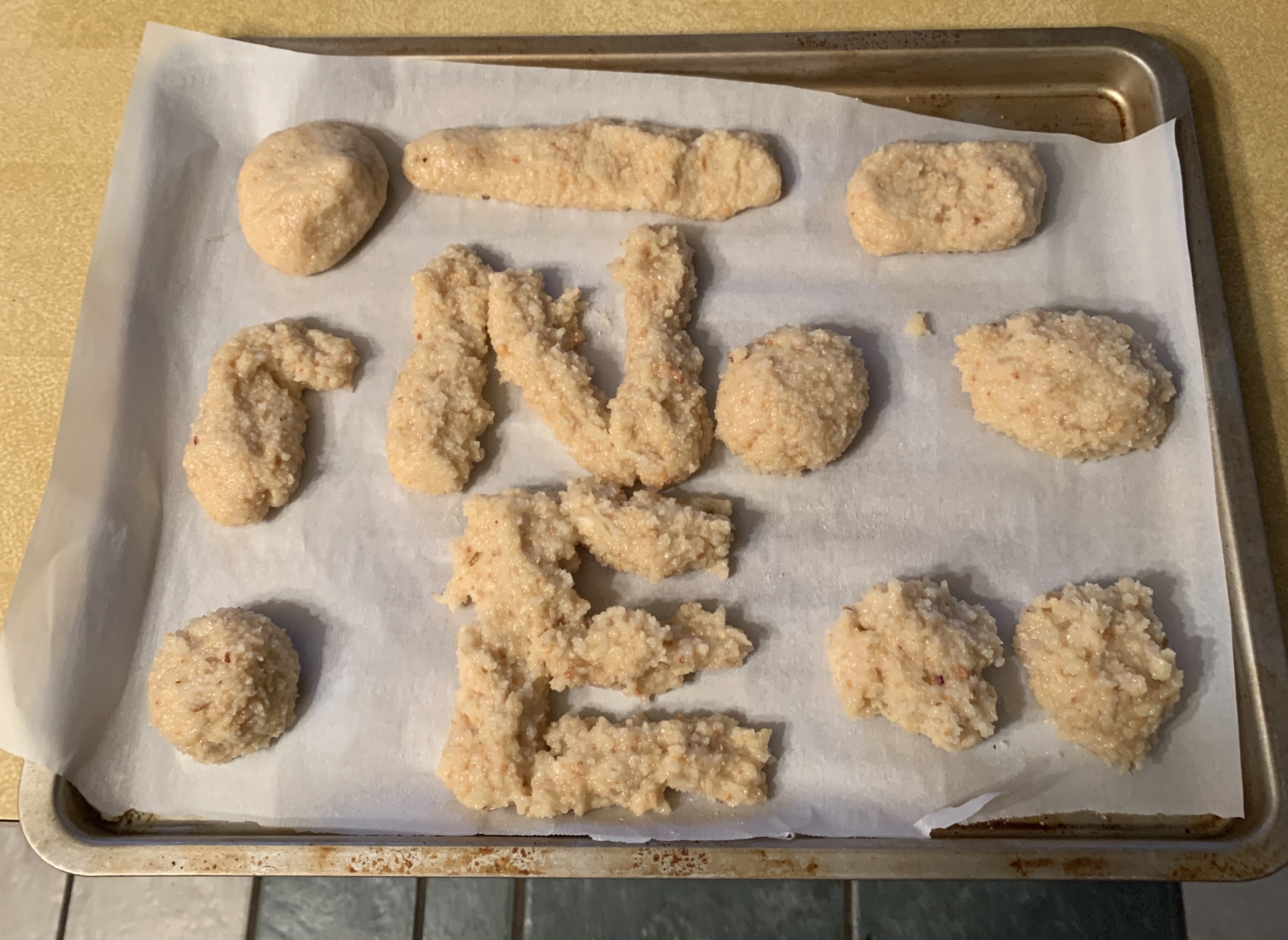
10. Afterwards, I baked the jumbals for 15 minutes at 350°F in a toaster oven. Adjustments may have to be made to cooking times and temperatures if using a larger oven.
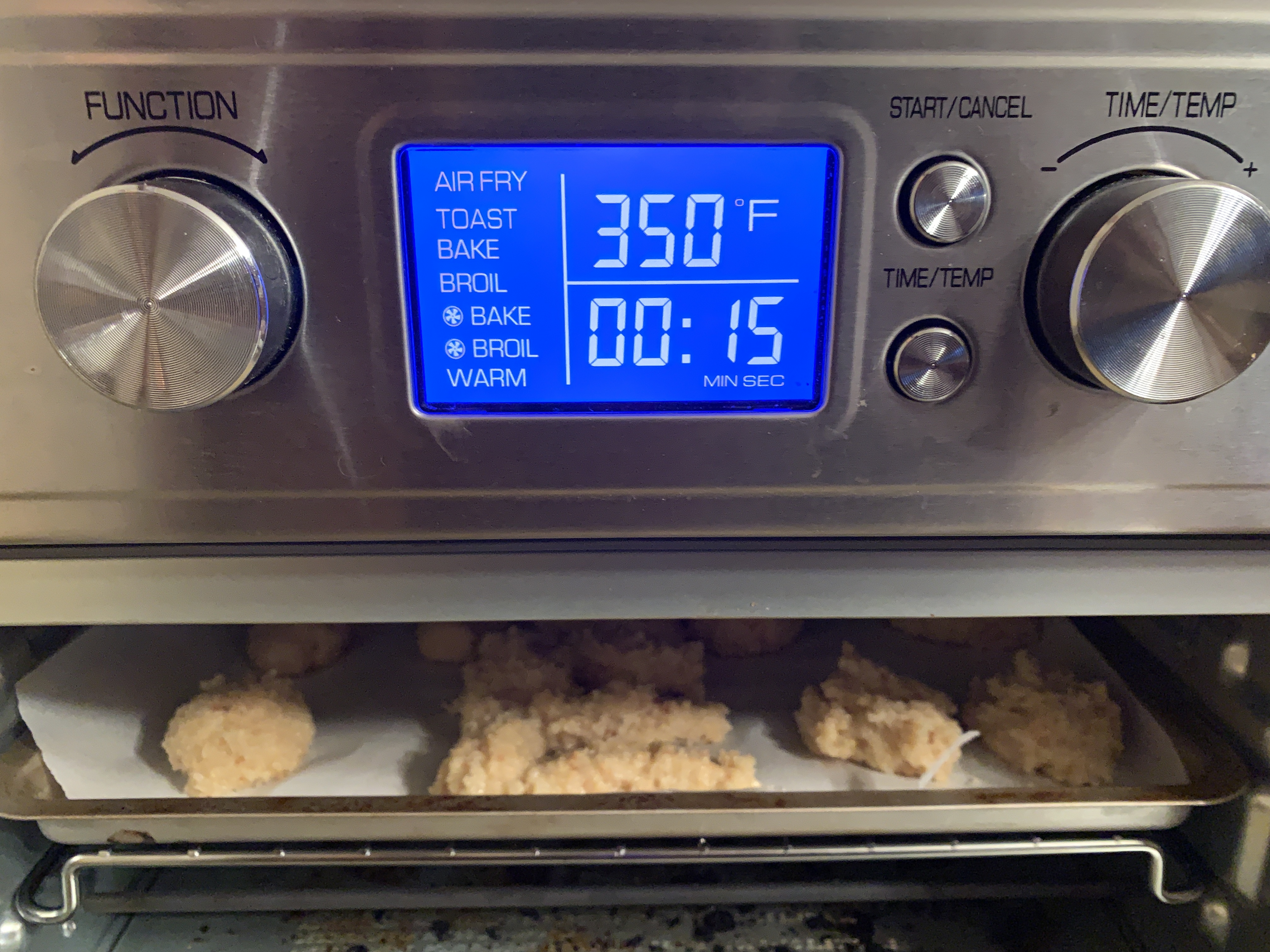
Results
The jumbals came out much better than I expected, both in texture and taste. They were crispy, chewy, and to me, closely resembled the texture and taste of a sweet biscuit. I felt like the cooking time for them was nearly perfect, only a bit overdone. This could be fixed by baking them for 2 or 3 less minutes in the future.
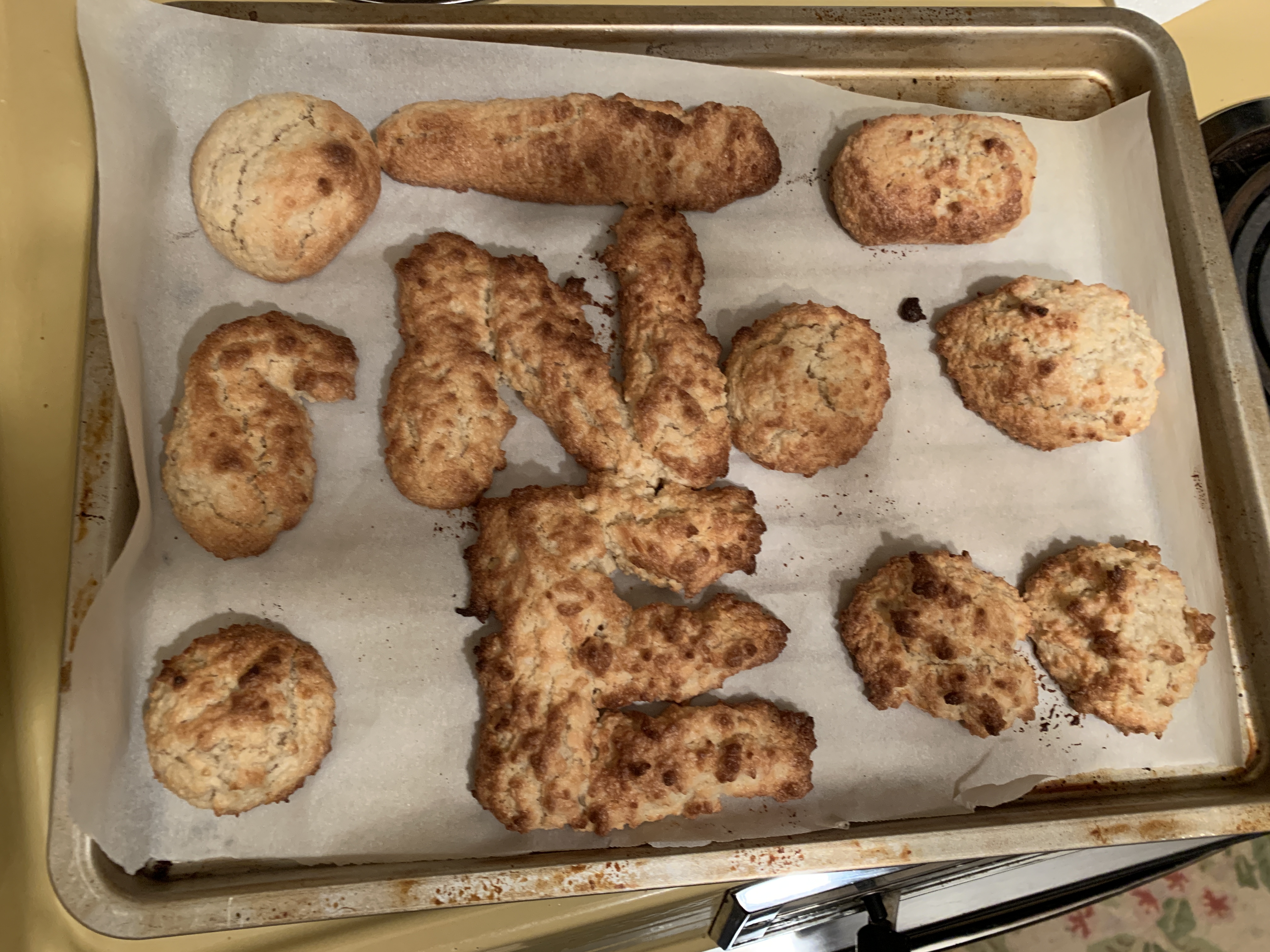
Baked Almond Jumbals
When tasting it, I felt that at the beginning of eating it, it was sweet and nutty. At the end however, there was hint of rose. However, there was not really much of the orange flavor from the flower water coming through, so in the future I would add maybe 2-3 tablespoons of it instead of 1. After the cookies cooled, they tasted much more strongly of rose flavor, which I enjoyed. If others making this recipe do not like rose flavor as much, however, I would maybe use 1/2 tablespoon of the rose water instead.

Overall, making the almond jumbals and researching about the origins of jumbals and the many recipes for them was an interesting experience, and I thought it was excellent that they turned out so well.
References
- Ms. Codex 214 – Cotton, Catharine – [Recipe book]
- “jumbal | jumble, n.” OED Online, Oxford University Press, March 2019, http://www.oed.com/view/Entry/102008;jsessionid=68F269A78C49AEB09F034A386F53C472. Accessed 15 March 2019.
- “biscuit, n.” OED Online, Oxford University Press, March 2019, http://www.oed.com/view/Entry/19429. Accessed 15 March 2019.
- “cake, n.” OED Online, Oxford University Press, March 2019, http://www.oed.com/view/Entry/26116. Accessed 15 March 2019.
- Markham, Gervase. The English Housewife. Edited by Michael R. Best, McGill-Queens University Press, 2014.
- Recipe for “Almond Jumballs”. Cookery and medicinal recipes [manuscript], ca. 1675-ca. 1750. Folger Manuscript V.a.429, fol. 52v.
- https://rarecooking.com/2016/06/16/cooking-almond-jumballs-at-the-folger-shakespeare-library/Cooking Almond Jumballs at the Folger Shakespeare Library | Cooking in the Archives – Cooking in the Archives | Updating Early Modern Recipes (1600-1800) in a Modern Kitchen. By Marissa Nicosia.